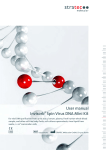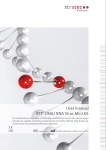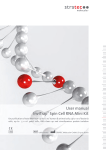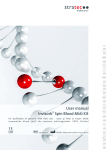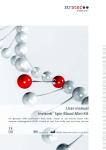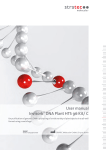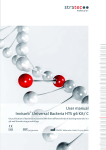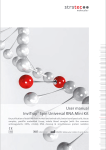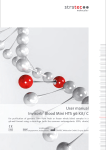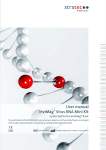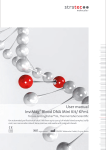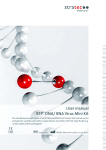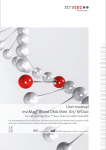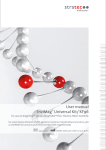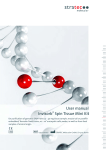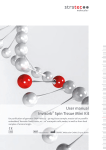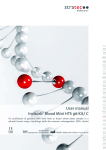Download Invisorb Spin Virus RNA Mini Kit
Transcript
User manual Invisorb® Spin Virus RNA Mini Kit for purification of viral RNA from up to 200 µl serum, plasma, and other cell-free body fluids, cell culture supernatants; rinse liquidfrom swabs; stool sample, cells, fresh or frozen tissue samples IVD REF 1040300x0 STRATEC Molecular GmbH, D-13125 Berlin Instruction for the Invisorb® Spin Virus RNA Mini Kit The Invisorb® Spin Virus RNA Mini Kit is the ideal tool using Invisorb® technology for the isolation and purification of high quality viral RNA from RNA viruses contained in up to 200 µl serum, plasma, cerebrospinal fluid, other cell free body fluids and cell culture supernatants, swab material, rinse liquid from swabs stool samples (max. 50 mg), cells (1 x 106 mammalian cells) and fresh or frozen tissue samples (max. 20 mg) for in vitro diagnostic purposes using a spin-filter format. Fresh or frozen plasma or serum from blood treated with anticoagulants like EDTA or citrate, but not with heparin, as well as small samples whole blood can be used. The kit is neither suitable for isolation of total RNA from whole blood, blood stains, cultured or isolated cells, tissue samples, bacteria, fungi, plants nor for purification of viral DNA. IVD Compliance with EU Directive 98/79/EC on in vitro medical devices. Not for in-vitro diagnostic use in countries where the EU Directive 98/79/EC on in vitro medical devices is not recognized. ® ® Trademarks: Invisorb , Eppendorf . Registered marks, trademarks, etc. used in this document, even when not specifically marked as such, are not to be considered unprotected by law. ® The Invisorb technology is covered by patents and patent applications: US 6,110363, US 6,043,354, US 6,037,465, EP 0880535, WO 9728171, WO 9534569, EP 0765335, DE 19506887, DE 10041825.2, WO 0034463. ® Invisorb is a registered trademark of STRATEC Biomedical AG. The PCR process is covered by US Patents 4,683,195, and 4,683,202 and foreign equivalents owned by Hoffmann-La Roche AG. © 2015 STRATEC Molecular, all rights reserved. 2 Invisorb® Spin Virus RNA Mini Kit 0515 Contents ® Kit content of the Invisorb Spin Virus RNA Mini Kit ................................................................................ 4 Symbols .......................................................................................................................................................... 5 Storage ........................................................................................................................................................... 5 Quality controland product warranty .......................................................................................................... 5 Intended use .................................................................................................................................................. 6 Product use limitation ................................................................................................................................... 6 Safety information ......................................................................................................................................... 7 ® Product characteristics of the Invisorb Spin Virus RNA Mini Kit ........................................................... 8 Principle and procedure ............................................................................................................................... 9 Lysis....................................................................................................................................................... 9 Binding viral RNA .................................................................................................................................. 9 Removing residual contaminants .......................................................................................................... 9 Elution .................................................................................................................................................... 9 Sampling and storage of starting material ................................................................................................. 9 Important points before starting a protocol ............................................................................................. 10 Important indication .................................................................................................................................... 10 Yield and quality of viral RNA .................................................................................................................... 11 Internal control (IC) / Extraction control ................................................................................................... 12 Preparing buffers ......................................................................................................................................... 12 Equipment and reagents to be supplied by user ..................................................................................... 12 ® Scheme of the Invisorb Spin Virus RNA Mini Kit .................................................................................... 13 Lysis procedures ......................................................................................................................................... 14 Preparation of a Master Mix ................................................................................................................ 14 Extraction control ................................................................................................................................ 14 Instructions .................................................................................................................................................. 15 Protocol 1 : Isolation of viral RNA from cell free body fluids (serum, plasma) .................................... 15 Protocol 2 : Isolation of viral RNA from swab material ........................................................................ 16 Protocol 3 : Isolation of viral RNA from cell culture supernatants ....................................................... 17 6 Protocol 4 : Isolation of viral RNA from 1 x 10 mammalian cells ....................................................... 18 Protocol 5 : Isolation of viral RNA from max 20 mg tissue samples.................................................... 19 Protocol 6 : Isolation of virus RNA from max. 50 mg stool samples ................................................... 20 Protocol 7 : Isolation of viral RNA whole blood ................................................................................... 21 Troubleshooting .......................................................................................................................................... 22 Appendix ...................................................................................................................................................... 23 General notes on handling RNA ................................................................................................................ 23 Storage of RNA ............................................................................................................................................ 23 Ordering information ................................................................................................................................... 24 Invisorb® Spin Virus RNA Mini Kit 0515 Kit content of the Invisorb® Spin Virus RNA Mini Kit Store dissolved Proteinase K at –20°C! Store lyophilized Carrier RNA at 2 – 8°C! Store dissolved Carrier RNA at - 80°C Store all other kit components at room temperature (RT)! Catalogue No. Lysis Buffer RV Carrier RNA Proteinase K Binding Solution (fill with 99.7% Isopropanol) Wash Buffer R1 5 viral RNA extractions 50 viral RNA extractions 250 viral RNA extractions 1040300100 1040300200 1040300300 2 x 2 ml 35 ml 170 ml for 240 µl for 1.2 ml for 3 x 2 ml working solution working solution working solution for 250 µl for 1.1 ml for 3 x 2 ml working solution working solution working solution 3 x 1 ml empty bottle empty bottle (ready to use) (final volume 30 ml) (final volume 120 ml) 15 ml 20 ml 80 ml (ready to use) (final volume 40 ml) (final volume160 ml) 15 ml 2 x 12 ml 2 x 40 ml (ready to use) (final volume 2 x 60 ml) (final volume 2 x 200 ml) Elution Buffer R 2 ml 15 ml 30 ml RNase Free Water 2 ml 2 ml 3 x 2 ml RTA Spin Filter Set 5 50 5 x 50 RTA Receiver Tubes 15 3 x 50 15 x 50 Receiver Tubes 2.0 ml 5 50 5 x 50 Elution Tubes 5 50 5 x 50 Manual 1 1 1 Wash Buffer R2 Initial steps Add 250 µl ddH2O to the tube with Proteinase K, mix thoroughly until completely dissolving and store at -20°C! Add 240 µl RNase Free Water to the Carrier RNA. Mix thoroughly until completely dissolving. Binding Solution, Wash Buffer R1 and R2 are ready for use. Add 1.1 ml ddH2O to the tube with Proteinase K, mix thoroughly until completely dissolving and store at -20°C! Add 2 ml ddH2O to each tube with Proteinase K, mix thoroughly until completely dissolving and store at -20°C! Fill 30 ml 99.7% Isopropanol (molecular biologic grade) into the empty bottle Fill 120 ml 99.7% Isopropanol (molecular biologic grade) into the empty bottle Add 1.2 ml RNase Free Water to the Carrier RNA. Mix thoroughly until completely dissolving. Add 2 ml RNase Free Water to each tube Carrier RNA. Mix thoroughly until completely dissolving. Add 20 ml 96-100% ethanol to the bottle Wash Buffer R1. Add 80 ml 96-100% ethanol to each bottle Wash Buffer R1. Add 48 ml 96-100% ethanol to each bottle Wash Buffer R2. Add 160 ml 96-100% ethanol to each bottle Wash Buffer R2. 4 Invisorb® Spin Virus RNA Mini Kit 0515 Symbols Manufacturer Lot number Catalogue number Expiry date Consult operating instructions Temperature limitation Do not reuse Storage All buffers and kit components, except the dissolved Proteinase K and the Carrier RNA, of the Invisorb® Spin Virus RNA Mini Kit should be stored well sealed and dry at room temperature (RT) and are stable for at least 12 months under these conditions. Carrier RNA is stable for at least 12 months. Proteinase K: Dissolved Proteinase K must be stored at –20 °C. Dividing Proteinase K into aliquots and storage at –20 °C is recommended. Carrier RNA: Lyophilized Carrier RNA can be stored at 2 - 8°C or RT, but the recommendation for long time storage is –20°C and is stable for at least 12 months. Dissolved Carrier RNA must be stored at -80°C, but repeated freezing and thawing will degrade the Carrier RNA and reduce the functionality of the kit. Therefore dividing Carrier RNA into aliquots and storage at –80°C is recommended. Dissolved Carrier RNA is stable for at least 6 months Wash Buffer R1 and R2 charged with ethanol should be appropriate sealed. Before every use make sure that all components have room temperature. If there are any precipitates within the provided solutions solve these precipitates by warming carefully. Room temperature is defined as range from 15 – 30°C. Quality control and product warranty STRATEC Molecular warrants the correct function of the Invisorb® Spin Virus RNA Mini Kit for applications as described in this manual. Purchaser must determine the suitability of the Product for its particular use. Should any Product fail to perform the applications as described in the manual, STRATEC Molecular will check the lot and if STRATEC Molecular investigates a problem in the lot, STRATEC Molecular will replace the Product free of charge. STRATEC Molecular reserves the right to change, alter, or modify any Product to enhance its performance and design at any time. In accordance with STRATEC Molecular’s ISO 9001-2000 and ISO EN 13485 certified Quality Management System the performance of all components of the Invisorb® Spin Virus RNA Mini Kit have been tested separately against predetermined specifications routinely on lot-to-lot to ensure consistent product quality. If you have any questions or problems regarding any aspects of Invisorb® Spin Virus RNA Mini Kit or other STRATEC Molecular products, please do not hesitate to contact us. A copy of STRATEC Molecular’s terms and conditions can be obtained upon request or are presented at the STRATEC Molecular webpage. For technical support or further information please contact: 5 Invisorb® Spin Virus RNA Mini Kit 0515 from Germany: +49-(0)30-9489-2901/ 2910 from abroad: +49-(0)30-9489-2903/ 2907 or contact your local distributor. Intended use The Invisorb® Spin Virus RNA Mini Kit is the ideal tool for reliable and fast manual isolation and purification of high quality viral RNA from serum, urine, plasma, cerebrospinal fluid, other cell free body fluids and cell culture supernatants, swab material, stool, cells, and tissue samples. For reproducible high yields an appropriate sample storage and quick operation under the rules for RNA operation is essential. The purified viral RNA is ready to use for in vitro diagnostic analysis only. The isolation protocol and all buffers are optimized to assure a high yield as well as a high purity of purified viral RNA. All manual work is reduced to a minimum. THE PRODUCT IS INTENDED FOR USE BY PROFESSIONALS ONLY, SUCH AS TECHNICIANS, PHYSICIANS AND BIOLOGISTS TRAINED IN MOLECULAR BIOLOGICAL TECHNIQUES. It is designed to be used with any downstream application employing enzymatic amplification or other enzymatic modifications of RNA followed by signal detection or amplification. Any diagnostic results generated by using the sample preparation procedure in conjunction with any downstream diagnostic assay should be interpreted with regard to other clinical or laboratory findings. To minimize irregularities in diagnostic results, adequate controls for downstream applications should be used. The kit is in compliance with EU Directive 98/79/EC on in vitro medical devices. But it is not for in-vitro diagnostic use in countries where the EU Directive 98/79/EC on in vitro medical devices is not recognized. Product use limitation The kit is neither validated for use with bone marrow, cultured cells nor for the isolation of total RNA from serum, plasma, blood, tissue or nor for the isolation of viral DNA. The included chemicals are only useable once. Differing of starting material or flow trace may lead to inoperability; therefore neither a warranty nor guarantee in this case will be given, neither implied nor express. The user is responsible to validate the performance of the STRATEC Molecular Product for any particular use. STRATEC Molecular does not provide for validation of performance characteristics of the Product with respect to specific applications. STRATEC Molecular Products may be used e.g.in clinical diagnostic laboratory systems conditioned upon the complete diagnostic system of the laboratory the laboratory has been validated pursuant to CLIA’ 88 regulations in the U.S. or equivalents in other countries. All Products sold by STRATEC Molecular are subject to extensive quality control procedures (according to ISO 9001-2000 and ISO EN 13485) and are warranted to perform as described herein. Any problems, incidents or defects shall be reported to STRATEC Molecular immediately upon detection thereof. The chemicals and the plastic parts are for laboratory use only; they must be stored in the laboratory and must not be used for purposes other than intended. The product with its contents is unfit for consumption. 6 Invisorb® Spin Virus RNA Mini Kit 0515 Safety information When and while working with chemicals, always wear a suitable lab coat, disposable gloves, and protective goggles! Avoid skin contact! Adhere to the legal requirements for working with biological material! For more information, please consult the appropriate material safety data sheets (MSDS). These are available online in convenient and compact PDF format at www.stratec.com for each STRATEC Molecular Product and its components. If buffer bottles are damaged or leaking, WEAR GLOVES, AND PROTECTIVE GOGGLES when discarding the bottles in order to avoid any injuries. STRATEC Molecular has not tested the liquid waste generated by the Invisorb® Spin Virus RNA Mini Kit procedures for residual infectious materials. Contamination of the liquid waste with residual infectious materials is highly unlikely, but cannot be excluded completely. Therefore, liquid waste must be considered infectious and be handled and discarded according to local safety regulations. European Community risk and safety phrases for the components of the Invisorb® Spin Virus RNA Mini Kit to which they apply are listed below as follows: Lysis Buffer RV Proteinase K: warning H302-312-332-412 EUH032 P273 danger H315-319-334-335 P280-305-351-338-310-405 Wash Buffer R1 warning H302-312-332-412 EUH032 P273 H302: H312: H332: H412: H315: H319: H334: H335: EUH032: P273: P280: P305+P351+P338: P310: P405: Harmful if swallowed. Harmful in contact with skin. Harmful if inhaled. Harmful to aquatic life with long lasting effects. Causes skin irritation. Causes serious eye irritation. May cause allergy or asthma symptoms or breathing difficulties if inhaled. May cause respiratory irritation. Contact with acids liberates very toxic gas. Avoid release to the environment. Wear protective gloves/protective clothing/eye protection/face protection. IF IN EYES: Rinse cautiously with water for several minutes. Remove contact lenses, if present and easy to do. Continue rinsing. Immediately call a POISON CENTER or doctor/physician. Store locked up. Emergency medical information can be obtained 24 hours a day from infotrac: outside of USA: in USA : 1 – 352 – 323 – 3500 1 – 800 – 535 – 5053 7 Invisorb® Spin Virus RNA Mini Kit 0515 Product characteristics of the Invisorb® Spin Virus RNA Mini Kit Starting material up to 200 µl cell free body fluids; swab material, rinsed liquid from swab; cell culture supernatants; 6 1 x 10 mammalian cells; max. 20 mg tissue sample; max. 50 mg stool sample; Yield Time depends on the sample (storage and source) 20 minutes Note: The added Carrier RNA will account for most of the eluted RNA. Quantitative RT-PCR is recommended for determination of the viral RNA yield. The Invisorb® Spin Virus RNA Mini Kit provides a fast and efficient way for reliable isolation of high quality viral RNA from RNA viruses found in a diverse range of starting material. The procedure is suitable for use with plasma or serum; either can contain Citrate or EDTA and other samples. Samples can be fresh, lyophilized or frozen, provided they have not been frozen and thawed more than ones. The procedure can be used for isolation of viral RNA from a broad range of RNA viruses. The amount of purified viral RNA in the Invisorb® Spin Virus RNA Mini Kit procedure depends on the sample type, the virus titer, sample source, transport, storage, and age. The Invisorb® Spin Virus RNA Mini Kit simplifies viral RNA isolation by combining efficient lyses of the starting material and the inactivation of exogenous and endogenous RNases. The sample will be lysed in an optimized Lysis Solution and proteins will be degraded during the lyses with Proteinase K. The liberated RNA is bound onto the membrane of the RTA Spin Filter. Contaminants are removed by repeated wash steps and the purified viral RNA can be eluted in a small volume of Elution Buffer R. The isolated viral RNA is ready to use and should be stored at - 80°C. Yield and quality of isolated viral RNA is suitable for any molecular-diagnostic detection system. The diagnostic tests should be performed according to manufacturer’s specifications. Due to the high purity, the isolated viral RNA is ready to use for a broad panel of downstream applications like: ○ ○ ○ ○ ○ RNA dot blots, cDNA transcription in vitro translation, RT-PCR*, TaqMan® analysis and array technologies. The purification procedure is rapid and does not require a phenol/ chloroform extraction. Only a minimum of manual work by the user is necessary. The procedure is designed to avoid sample-to-sample cross-contaminations and allow safe handling of potentially infectious samples. The procedure is highly suited for simultaneous processing of multiple samples. Traditional time-killing procedures can be replaced using the Invisorb® Spin Virus RNA Mini Kit. STRATEC Molecular also offers a system for the purification of viral RNA from serum and plasma in a 96 well format, Invisorb® Virus RNA Mini Kit KF96. The Invisorb® Virus RNA HTS 96-Kit/X is designed for on X-tractor GeneTM (Corbett Robotics). The InviMag® Virus DNA/RNA Mini Kit/ KFml and the RTP® Virus DNA/RNA Mini Kit have been developed for isolation of viral DNA or viral RNA. If you are interested in using the kit on a laboratory workstation, please do not hesitate to contact our technical support (+49 (0)30-9489-2907). For technical support or further information please contact: +49 (0)30-9489-2901/ 2903/ 2907/ 2910 or your local distributor. * The PCR process is covered by US Patents 4,683,195, and 4,683,202 and foreign equivalents owned by Hoffmann-La Roche AG. 8 Invisorb® Spin Virus RNA Mini Kit 0515 Principle and procedure The Invisorb® Spin Virus RNA Mini Kit procedure comprises the following steps: ○ ○ lyses of the virus particle adjustment of the binding conditions, followed by the transfer of the sample into the RNA binding RTA Spin Filter ○ binding of the viral RNA to the membrane of the RTA Spin Filter ○ washing of the membrane and elimination of contaminants and ethanol.Elution of highly pure viral RNA from the membrane Repeated wash steps make sure that contaminations and enzyme inhibitors are efficiently removed and high purified RNA is eluted in Elution Buffer R or Rnase free water. This manual contains 6 protocols. Lysis Samples are lysed under denaturing conditions at elevated temperatures. Due to the strong denaturing lyses conditions in the presence of Proteinase K and Lysis Buffer RV cells are quickly broken and RNases are inactivated simultaneously. The viral RNA is secured. The addition of Carrier RNA is necessary for the enhancement of viral RNA recovery so a very small number of viral RNA molecules will also be purified. Carrier RNA also stabilizes nucleic acids in samples with very small nucleic acid concentrations. Binding viral RNA After adding Binding Solution to optimize the binding of viral RNA to the RTA Spin Filter membrane, the lysate will be applied onto the RTA Spin Filter and the viral RNA is bound to the surface of the RTA Filter membrane as the lysate is drawn through by centrifugation. Removing residual contaminants Contaminants are efficiently washed away using Wash Buffer R1 and R2, while the viral RNA remains bound to the membrane of the RTA Spin Filter. Elution High quality viral RNA is eluted from the membrane using Elution Buffer R (or RNase Free Water). The eluted RNA is ready to use in different subsequent applications. Sampling and storage of starting material Best results are obtained using freshly extracted samples. As long as the samples are not shock frosted with liquid nitrogen or are incubated with RNase inhibitors or denaturing reagents, the RNA is not secured. Therefore it is essential, that samples are immediately flash frozen subsequent to the harvesting by using liquid nitrogen and are stored at -80°C. RNA contained in such deep frozen samples is stable for months. RNA purification should be processed as soon as possible. Samples can also be stored in Lysis Buffer RV for 1 h at room temperature, overnight at 4°C, and for long term storage at –80°C. Storage under deep frozen conditions is recommended. Serum, plasma, urine, cerebrospinal fluid or other cell free body fluids, as well as cell culture supernatants, swabs, and stool samples can be stored on ice for 1 - 2 hours, for short time (up to 24 h) samples may be stored at -20°C. For long term storage, we recommend freezing samples at –80°C. Multiple thawing and freezing before isolating the viral RNA should be avoided. Serum and plasma (and other cell free body fluids) Following centrifugation, plasma or serum from blood treated with anticoagulants like EDTA or citrate, but not with heparin, can be stored at 2–8°C for up to 6 hours. For longterm storage, freezing at –20°C to –80°C in aliquots is recommended. Repeated freezing 9 Invisorb® Spin Virus RNA Mini Kit 0515 and thawing cycles must be avoided because denaturation and precipitation of proteins result in a decrease of the virus titer and thereby reduce the yield of the extracted viral RNA. Occurring cryoprecipitates can be pelleted by briefly centrifuging (6.800 x g for 3 min). The cleared supernatant should be removed, without disturbing the pellet, and processed immediately. This step will not reduce viral titers. Tissue samples (biopsy material or frozen section) Best results are obtained with fresh material or material that has been immediately flash frozen and stored at –20°C or –80°C. Repeated freezing and thawing of stored samples should be avoided, since this leads to reduced RNA yield. Use of poor quality starting material influences the RNA yield, too. The amount of purified RNA in the Invisorb® Spin Virus RNA Mini Kit procedure using up to 20 mg tissue sample, depends on kind of starting material. The thawing process could be proceed, e.g. directly in Lysis Buffer RV. STRATEC Molecular will be released of its responsibilities if other sample materials than described in the Intended Use are processed or if the sample preparation protocols are changed or modified. Important points before starting a protocol Immediately upon receipt of the Product, inspect the Product and its components as well as the package for any apparent damages, correct quantities and quality. If there are any unconformities you have to notify STRATEC Molecular in writing with immediate effect upon inspection thereof. If buffer bottles are damaged, contact the STRATEC Molecular Technical Services or your local distributor. In case of liquid spillage, refer to “Safety Information” (see page 7). Do not use damaged kit components, since their use may lead to poor kit performance. ○ ○ ○ ○ ○ ○ ○ ○ Always change pipet tips between liquid transfers. To avoid cross-contaminations, we recommend the use of aerosol-barrier pipet tips. All centrifugation steps are carried out at room temperature. When working with chemicals, always wear a suitable lab coat, disposable gloves, and protective goggles. Discard gloves if they become contaminated. Do not combine components of different kits unless the lot numbers are identical. Avoid microbial contamination of the kit reagents. To minimize the risk of infections from potentially infectious material, we recommend working under laminar air-flow until the samples are lysed. This kit should only be used by trained personnel. Important indications Preparing RNA When preparing viral RNA, work quickly during the manual steps of the procedure. The Lysis Buffer RV of the Invisorb® Spin Virus RNA Mini Kit simplifies viral RNA isolation by combining efficient lyses of the starting material and the inactivation of exogenous and endogenous RNases. Extreme care should be taken to avoid contaminations with RNases when handling Elution Buffer R. Storing samples Frozen Serum or plasma samples must not be thawed more than ones. Repeated freeze – thawing leads to denaturation and precipitation of proteins, resulting in reduced viral titers and therefore reduced yields of viral nucleic acids. In addition cryoprecipitate formed during freeze and thawing will clog the RTA Spin Filter membrane. 10 Invisorb® Spin Virus RNA Mini Kit 0515 Adding carrier RNA Carrier RNA serves two purposes. Firstly, it enhances the binding of viral acids to the RTA Spin Filter membrane, especially if there are very few target molecules in the sample. Secondly, the addition of large amounts of Carrier RNA reduces the chance of viral RNA degradation in the rare event that RNase molecules are not denaturated by the chaotropic salt and detergents in the Lysis Buffer RV. If Carrier RNA is not added to the Lysis Buffer RV, this may lead to reduced viral RNA recovery. The use of an internal control is recommended when using the Invisorb® Spin Virus RNA Mini Kit in combination with diagnostic amplification systems. Internal Control RNA and reconstituted Carrier RNA should be added to the Lysis Buffer RV and mixed thoroughly by inverting the tube 10 times. To avoid foaming, do not vortex. Eluting viral RNA For downstream applications, that require small staring volumes, using viral RNA eluted in 40 µl Elution Buffer R may increase assay sensitivity. The volume of eluate recovered may be up to 5 µl less than the volume of elution buffer applied to the RTA Spin Filter. The volume of eluate recovered depends on the nature of the sample. Handling of RTA Spin Filter Due to the sensitivity of viral RNA amplification technologies the following precautions are necessary when handling RTA Spin Filter to avoid cross-contamination between sample preparations: ○ ○ ○ ○ ○ carefully apply the sample or solution to the RTA Spin Filter, pipet the sample into the filter without wetting the rim of the column always change pipet tips between liquid transfers, we recommend the use of aerosolbarrier pipet tips avoid touching the RTA Spin Filter membrane with the pipet tip Yield and quality of viral RNA Different amplification systems vary in efficiency depending on the total amount of nucleic acid present in the reaction. Eluates derived by this kit will contain Carrier-RNA, which will greatly exceed the amount of the isolated NA. Yields of viral nucleic acids isolated from biological samples are usually low concentrated and therefore almost impossible to determine photometrically.* * Keep in mind that the Carrier-RNA (5 μg per 200 μl sample) will account for most of the present RNA. The kit is suitable for downstream analysis with NAT techniques, for examples qPCR, RT qPCR, LAMP, LCR. Diagnostic assays should be performed according to the manufacturer’s instructions. Quantitative RT-PCR is recommended for determination of viral RNA yield. * In Gel Electrophoresis and in Capillary Electrophoresis, RNA extracted with the provided kit looks like degraded cause the kit contains Carrier RNA, this is poly A RNA in fragments of 100 up to 1000 bases. The kit is not dedicated for applications using this kind of analysis. 11 Invisorb® Spin Virus RNA Mini Kit 0515 Internal control (IC) / Extraction control Internal Controls (IC) from the PCR assay provider can be used as extraction controls if the fragments are longer than 100 bp. In this case they have to be added after finalization of the lysis step. Alternatively it can be mixed with the Carrier RNA. Attention: don´t add directly these Internal Controls to the sample! Preparing buffers 5 viral RNA-extractions: Add 250 µl ddH2O to the tube with Proteinase K, mix thoroughly until completely dissolving and store at -20°C! Add 240 µl RNase Free Water to the Carrier RNA. Mix thoroughly until completely dissolving. Binding Solution, Wash Buffer R1 and R2 are ready to use! 50 viral RNA-extractions: Add 1.1 ml ddH2O to the tube with Proteinase K, mix thoroughly until completely dissolving and store at -20°C! Fill 30 ml 99.7% Isopropanol (molecular biologic grade) into the empty bottle Add 1200 µl RNase Free Water to the Carrier RNA. Mix thoroughly until completely dissolving. Add 20 ml 96-100% ethanol to the bottle Wash Buffer R1. Add 48 ml 96-100% ethanol to each bottle Wash Buffer R2. 250 viral RNA-extractions: Add 2 ml ddH2O to the tube with Proteinase K, mix thoroughly until completely dissolving and store at -20°C! Fill 120 ml 99.7% Isopropanol (molecular biologic grade) into the empty bottle Add 2 ml RNase Free Water to the Carrier RNA. Mix thoroughly until completely dissolving. Add 80 ml 96-100% ethanol to each bottle Wash Buffer R1. Add 160 ml 96-100% ethanol to each bottle Wash Buffer R2. Equipment and reagents to be supplied by user When working with chemicals, always wear a suitable lab coat, disposable gloves and protective goggles. For more information’s, please consult the appropriate material safety data sheets (MSDS). (See our webpage: www.stratec.com) o o o o o Microcentrifuge (≥ 11.000 rpm) Thermomixer (65°C-80°C) ddH2O Ethanol (96-100%) Isopropanol * *The Invisorb® Spin Virus RNA Mini Kit is validated with 2-Propanol; Rotipuran >99.7%, p.a., ACS, ISO (Order no. 6752) from Carl Roth * Possible suppliers for Isopropanol: Carl Roth 2-Propanol Rotipuran >99.7%, p.a., ACS, ISO Order no. 6752 Applichem 2-Propanol für die Molekularbiologie Order no. A3928 12 Sigma 2-Propanol Order no. 59304-1L-F Invisorb® Spin Virus RNA Mini Kit 0515 Scheme of the Invisorb® Spin Virus RNA Mini Kit Please work quickly and perform all extraction steps at room temperature (RT)! Please read the protocols carefully prior to the start of the preparation procedure! transfer 200 µl sample into a 2.0 ml Receiver Tube add 600 µl Lysis Buffer RV, 20 µl Carrier RNA, and 20 µl Proteinase K or or: add 640 µl Mastermix (see page 14) incubate for 10 minutes at 65°C in a thermomixer Add the Internal Control to each sample** or check page 14 for realization of the optimal binding conditions add 400 µl Binding Solution and mix the sample completely by pipetting up and down or by vortexing transfer 650 µl of the sample on the RTA Spin Filter, incubate for 1 min and centrifuge for 1 min at 5.900 x g (8.000 rpm) discard the flow through, transfer the residual sample into the RTA Spin Filter, incubate for 1 min and centrifuge for 1 min at 5.900 x g (8.000 rpm) transfer the RTA Spin Filter into a new RTA Receiver Tube pipet 600 µl Wash Buffer R1 onto the RTA Spin Filter and centrifuge for 1 min at 5.900 x g (8.000 rpm) discard the flow through and the RTA Receiver Tube transfer the RTA Spin Filter into a new RTA Receiver Tube pipet 600 µl Wash Buffer R2 onto the RTA Spin Filter and centrifuge for 1 min at 5.900 x g (8.000 rpm) discard the flow through transfer the RTA Spin Filter into a new RTA Receiver Tube (Repeat this washing step!) to eliminate any traces of ethanol, centrifuge again for 1 min at maximum speed discard the RTA Receiver Tube transfer the RTA Spin Filter into a RNase free 1.5 ml Elution Tube pipet 50 - 100 µl of Elution Buffer R (preheated to 65°C) directly onto the membrane of the RTA Spin Filter, incubate for 3 min and centrifuge for 1 min at 5.900 x g (8.000 rpm) discard the RTA Spin Filter and place the eluted viral RNA immediately on ice! 13 Invisorb® Spin Virus RNA Mini Kit 0515 Lysis procedures For easier handling we recommend to prepare a Master Mix only for the needed amount of samples consisting of Lysis Buffer RV, Proteinase K and if required Carrier RNA. When preparing the Master Mix it is recommended to use a volume of 5 % greater than that required. The Master Mix is stable for at least 2h at RT. Preparation of a Master Mix Number of samples Amount of Lysis Buffer RV Amount of Carrier RNA Amount of Proteinase K 6 600 µl / sample 3.9 ml 20 µl / sample 130 µl 20 µl / sample 130 µl 8 5.1 ml 170 µl 170 µl 10 6.3 ml 210 µl 210 µl 12 7.8 ml 260 µl 260 µl 16 10.2 ml 340 µl 340 µl 20 12.6 ml 420 µl 420 µl 24 15.0 ml 500 µl 500 µl 32 20.1 ml 670 µl 670 µl 40 25.2 ml 840 µl 840 µl 48 30.0 ml 1000 µl 1000 µl Extraction control Extraction control DNA or RNA must be combined with the provided Carrier RNA in one mixture. The vials with Carrier RNA contain 240 µl, 1.2 ml or 2.0 ml stock solutions depending on the package size. Add the respective amount of Extraction Control Nucleic Acid to the Carrier RNA, replace the according amount of RNAse free water. Then you may add the respective mixture to the master mix, please note that this is just possible, if all the samples need the same control! Notes: If you only have indication of amount per reaction, please calculate by using eluate and template volume. If the extraction control is stable in plasma, serum, CSF, urine, respiratory samples, whole blood, stool, transport media, or on dried swabs (e.g., armored RNA), it can alternatively be added to the sample shortly before beginning sample preparation. If the extraction control is naked DNA or RNA, it is unstable in plasma, serum, CSF, urine, respiratory samples, whole blood, stool, transport media, or on dried swabs and must not be added directly to the samples. You may add it together with the carrier RNA, or after finishing the Lysis Step, before continuing with step 2. Refer to the manufacturer’s instructions to determine the optimal amount of extraction control for specific downstream applications. Using an amount other than that recommended may lead to wrong quantification results. 14 Invisorb® Spin Virus RNA Mini Kit 0515 Instructions The following notes are valid for all protocols: Note: The RNA can also be eluted with a lower (but not lower than 40 µl) or a higher volume of Elution Buffer R (depends on the expected yield or needed concentration of RNA). Important After extraction place the Elution Tube on ice. For a long time storage place the nucleic acids at –20°C or –80°C. Note: The centrifugation steps were made with the Centrifuge 5415 D from Eppendorf. The indicated rpm amounts are referring to this centrifuge. Protocol 1: Isolation of viral RNA from serum, plasma or other cell free body fluids Please read the instructions carefully and conduct the prepared procedure. Important Preheat the prospective volume of the Elution Buffer R to 80°C for the final elution step. The protocol has been optimized for the isolation of RNA from body fluids of 200 µl. For samples which have a smaller volume than 200 µl please fill up to a total volume of 200 µl with ddH2O. 1. Sample Lysis Mix samples smaller than 200 µl with ddH2O to a total volume of 200 µl. Transfer the sample in a 2.0 ml Receiver Tube. Add 600 µl Lysis Buffer RV, 20 µl Carrier RNA and 20 µl Proteinase K to the sample. Close the cap and vortex shortly. Place the Receiver Tube into a thermomixer and incubate under continuously shaking at 65°C for 10 min. Add the Internal Control 2. Binding of the RNA Add 400 µl Binding Solution to the tube with the lysed sample and mix the sample completely by pipetting up and down or by vortexing. Transfer 650 µl of the sample into the RTA Spin Filter Set. Close the tube, incubate for 1 min at RT and centrifuge for 1 minute at 5.900 x g (8.000 rpm). Discard the filtrate and transfer the residual sample into the RTA Spin Filter Set. Close the cap, incubate for 1 min at RT and centrifuge at 5.900 x g (8.000 rpm) for 1 min. Discard the RTA Receiver Tube with filtrate and place the RTA Spin Filter into a new RTA Receiver Tube. 3. First Washing of the RTA Spin Filter Add 600 µl Wash Buffer R1 to the RTA Spin Filter and centrifuge for 1 min at 5.900 x g (8.000 rpm). Discard the filtrate and place the RTA Spin Filter into a new RTA Receiver Tube. 4. Second Washing of the RTA Spin Filter Add 600 µl Wash Buffer R2 to the RTA Spin Filter and centrifuge for 1 min at 5.900 x g (8.000 rpm). Discard the filtrate, place the RTA Spin Filter again into a new RTA Receiver Tube and repeat the second washing step. Remove the residual ethanol by final centrifugation for 4 min at maximum speed. 5. Elution of the RNA Place the RTA Spin Filter into a 1.5 ml Elution Tube and add 100 µl of the Elution Buffer R (preheated to 80°C) directly onto the RTA Spin Filter surface. Incubate for 3 min. and centrifuge at 5.900 x g (8.000 rpm) for 1 min. 15 Invisorb® Spin Virus RNA Mini Kit 0515 Protocol 2: Isolation of viral RNA from swab material Please read the instructions carefully and conduct the prepared procedure. Important Preheat the prospective volume of the Elution Buffer R to 80°C for the final elution step. If the swab is delivered in a stabilization media, make sure that these media are suitable for RNA virus stabilization. If you are not sure please contact the manufacturer. Some RNA virus stabilizing media dissolve the viral particles. They may be used by transferring 200 µl directly into the 2.0 ml Receiver Tubes and continue with step 1. 1. Sample Lysis A) If you get a swab without transport media, please follow the instructions below: ○ rinse each swab with 500 µl cooled water or cooled PBS and use a 200 µl aliquot of the liquid for viral RNA extraction. ○ transfer each sample in a 2.0 ml Receiver Tube and follow the protocol B) If you want use the swab direct: place the swab in a 2.0 ml Receiver Tube and add 200 µl ddH2O. Add 600 µl Lysis Buffer RV, 20 µl Carrier RNA and 20 µl Proteinase K to the sample. Close the cap and vortex shortly. Place the Receiver Tube into a thermomixer and incubate under continuously shaking for 10 min. at 65°C. Add the Internal Control Important Note: To get maximum yield of viral nucleic acids it is essential to leave the swab during the complete lysis time into the reaction tube. It is possible to cut the shaft of the swab, so that you can close the cap of the tube. The removing of the swab from the tube ahead of time will be lead to a dramatically reduced final yield ! After lysis time carefully squeeze out the swab on the wall of the tube and discard the swab. 2. Binding of the RNA Add 400 µl Binding Solution to the tube with the lysed sample and mix the sample completely by pipetting up and down or by vortexing. Transfer 650 µl of the sample into the RTA Spin Filter Set. Close the tube, incubate for 1 min at RT and centrifuge for 1 minute at 5.900 x g (8.000 rpm). Discard the filtrate and transfer the residual sample into the RTA Spin Filter Set. Close the cap, incubate for 1 min at RT and centrifuge at 5.900 x g (8.000 rpm) for 1 min. Discard the RTA Receiver Tube with filtrate and place the RTA Spin Filter into a new RTA Receiver Tube 3. First Washing of the RTA Spin Filter Add 600 µl Wash Buffer R1 to the RTA Spin Filter and centrifuge for 1 min at 5.900 x g (8.000 rpm). Discard the filtrate and place the RTA Spin Filter into a new RTA Receiver Tube. 4. Second Washing of the RTA Spin Filter Add 600 µl Wash Buffer R2 to the RTA Spin Filter and centrifuge for 1 min at 5.900 x g (8.000 rpm). Discard the filtrate, place the RTA Spin Filter again into a new RTA Receiver Tube and repeat the second washing step. Remove the residual ethanol by final centrifugation for 4 min at maximum speed. 5. Elution of the RNA Place the RTA Spin Filter into a 1.5 ml Elution Tube and add 100 µl of the Elution Buffer R (preheated to 80°C) directly onto the RTA Spin Filter surface. Incubate for 3 min. and centrifuge at 8.000 rpm for 1 min. 16 Invisorb® Spin Virus RNA Mini Kit 0515 Protocol 3: Isolation of viral RNA from cell culture supernatants Please read the instructions carefully and conduct the prepared procedure. Important Preheat the prospective volume of the Elution Buffer R to 80°C for the final elution step. 1. Sample Lysis Transfer 200 µl of the cell culture supernatant (cell culture media) into a 2.0 ml Receiver Tube. Add 600 µl Lysis Buffer RV, 20 µl Carrier RNA and 20 µl Proteinase K to the sample. Close the cap and vortex shortly. Place the tube into a thermomixer and incubate under continuously shaking for 10 minutes at 65°C. Add the Internal Control 2. Binding of the RNA Add 400 µl Binding Solution to the tube with the lysed sample and mix the sample completely by pipetting up and down or by vortexing. Transfer 650 µl of the sample into the RTA Spin Filter Set. Close the tube, incubate for 1 min at RT and centrifuge for 1 minute at 5.900 x g (8.000 rpm). Discard the filtrate and transfer the residual sample into the RTA Spin Filter Set. Close the cap, incubate for 1 min at RT and centrifuge at 5.900 x g (8.000 rpm) for 1 min. Discard the RTA Receiver Tube with filtrate and place the RTA Spin Filter into a new RTA Receiver Tube. 3. First Washing of the RTA Spin Filter Add 600 µl Wash Buffer R1 to the RTA Spin Filter and centrifuge for 1 min at 5.900 x g (8.000 rpm). Discard the filtrate and place the RTA Spin Filter into a new RTA Receiver Tube. 4. Second Washing of the RTA Spin Filter Add 600 µl Wash Buffer R2 to the RTA Spin Filter and centrifuge for 1 min at 8.000 rpm. Discard the filtrate, place the RTA Spin Filter again into a new RTA Receiver Tube and repeat the second washing step. Remove the residual ethanol by final centrifugation for 4 min at maximum speed. 5. Elution of the RNA Place the RTA Spin Filter into a 1.5 ml Elution Tube and add 100 µl of the Elution Buffer R (preheated to 80°C) directly onto the RTA Spin Filter surface. Incubate for 3 min. and centrifuge at 5.900 x g (8.000 rpm) for 1 min. 17 Invisorb® Spin Virus RNA Mini Kit 0515 Protocol 4: Isolation of viral RNA from 1 x 106 mammalian cells Please read the instructions carefully and conduct the prepared procedure. Important Preheat the prospective volume of the Elution Buffer R to 80°C for the final elution step. Harvest cells Cells grown in suspension: Spin up to 1 x 106 cells for 5 min at 1.500 rpm. Discard the supernatant and remove all media completely. Cells grown in a monolayer: In large culture vessels (dishes > ∅ 35 mm, flasks > 12.5 cm2) detach cells by trypsination. Transfer the cells to a centrifuge tube and sediment by centrifugation at 1.500 rpm for 5 min. Remove the supernatant completely. In small culture vessels (96-, 24-, 12-, 6-well plates, ∅ 35 mm dishes, 12.5 cm2 flasks) discard the media completely and continue with the lysis immediately. Important: Incomplete removal of the cell culture media will inhibit the lysis and dilute the lysate which will affect the binding of RNA to the RTA Spin Filter. Disrupt cells by adding Lysis Buffer RV For pelleted cells: Loosen cell pellet by flicking the tube and add 600 µl Lysis Buffer RV, 200 µl ddH2O, 20 µl Carrier RNA and 20 µl Proteinase K. Close the cap and vortex shortly. No cell clumps should be visible before proceeding with the next step. Pipet the lysed mixture into a 2.0 ml reaction tube. For monolayer cells: Add 600 µl Lysis Buffer RV, 200 µl ddH2O, 20 µl Carrier RNA and 20 µl Proteinase K to monolayer cells. Collect cell lysate with a rubber policeman. Mix thoroughly by pipetting up and down. No cell clumps should be visible before proceeding with the next step. Pipet the lysed mixture into 2.0 ml reaction tube. 1. Sample Lysis Place the tube with the sample into a thermomixer and incubate under continuously shaking for 10 minutes at 65°C. Add the Internal Control 2. Binding of the RNA Add 400 µl Binding Solution to the tube with the lysed sample and mix the sample completely by pipetting up and down or by vortexing. Transfer 650 µl of the sample into the RTA Spin Filter Set. Close the tube, incubate for 1 min at RT and centrifuge for 1 minute at 5.900 x g (8.000 rpm). Discard the filtrate and transfer the residual sample into the RTA Spin Filter Set. Close the cap, incubate for 1 min at RT and centrifuge at 5.900 x g (8.000 rpm) for 1 min. Discard the RTA Receiver Tube with filtrate and place the RTA Spin Filter into a new RTA Receiver Tube. 3. First Washing of the RTA Spin Filter Add 600 µl Wash Buffer R1 to the RTA Spin Filter and centrifuge for 1 min at 5.900 x g (8.000 rpm). Discard the filtrate and place the RTA Spin Filter into a new RTA Receiver Tube. 4. Second Washing of the RTA Spin Filter Add 600 µl Wash Buffer R2 to the RTA Spin Filter and centrifuge for 1 min at 5.900 x g (8.000 rpm). Discard the filtrate, place the RTA Spin Filter again into a new RTA Receiver Tube and repeat the second washing step. Remove the residual ethanol by final centrifugation for 4 min at maximum speed. 5. Elution of the RNA Place the RTA Spin Filter into a 1.5 ml Elution Tube and add 100 µl of the Elution Buffer R (preheated to 80°C) directly onto the RTA Spin Filter surface. Incubate for 3 min. and centrifuge at 5.900 x g (8.000 rpm) for 1 min. 18 Invisorb® Spin Virus RNA Mini Kit 0515 Protocol 5: Isolation of viral RNA from max. 20 mg tissue samples Please read the instructions carefully and conduct the prepared procedure. Important Preheat the prospective volume of the Elution Buffer R to 80°C for the final elution step. Disruption and lysis of the starting material Note: To maximize the final yield of viral RNA a complete disruption of tissue sample is important! For the disruption of starting material it is possible to use commercially available rotor-stator homogenizer or bead mills. It is also possible to disrupt the starting material using mortar and pestle in liquid nitrogen and grind the tissue sample to a fine powder. ○ using rotor-stator homogenizer 1. Transfer the weighed amount of fresh or frozen starting material in a suitable reaction vesicle for the homogenizer. 2. Add 600 µl Lysis Buffer RV and 200µl ddH20 (vigorously mixed before adding). 3. Homogenize the sample. 4. Transfer the sample into a 2.0 ml reaction tube and place the homogenate for longer storage at –20°C or use the sample immediately for isolation of viral RNA following the protocol step 1. ○ using a mortar and pestle and liquid nitrogen 1. Transfer the weighed amount of fresh or frozen starting material under liquid nitrogen and grind the material to a fine tissue powder. 2. Transfer the powder into a 2.0 ml Receiver Tube. Do not allow the sample to thaw! 3. Add 600 µl Lysis Buffer RV and 200 µl ddH20 to the sample and follow protocol step 1. 1. Sample Lysis Add 20 µl Carrier RNA and 20 µl Proteinase K to the homogenate. Close the cap and vortex shortly. Place the Receiver Tube into a thermomixer and incubate under continuously shaking for 10 minutes at 65°C. Add the Internal Control 2. Binding of the RNA Add 400 µl Binding Solution to the tube with the lysed sample and mix the sample completely by pipetting up and down or by vortexing. Transfer 650 µl of the sample into the RTA Spin Filter Set. Close the tube, incubate for 1 min at RT and centrifuge for 1 minute at 5.900 x g (8.000 rpm). Discard the filtrate and transfer the residual sample into the RTA Spin Filter Set. Close the cap, incubate for 1 min at RT and centrifuge at 5.900 x g (8.000 rpm) for 1 min. Discard the RTA Receiver Tube with filtrate and place the RTA Spin Filter into a new RTA Receiver Tube. 3. First Washing of the RTA Spin Filter Add 600 µl Wash Buffer R1 to the RTA Spin Filter and centrifuge for 1 min at 5.900 x g (8.000 rpm). Discard the filtrate and place the RTA Spin Filter into a new RTA Receiver Tube. 4. Second Washing of the RTA Spin Filter Add 600 µl Wash Buffer R2 to the RTA Spin Filter and centrifuge for 1 min at 5.900 x g (8.000 rpm). Discard the filtrate, place the RTA Spin Filter again into a new RTA Receiver Tube and repeat the second washing step. Remove the residual ethanol by final centrifugation for 4 min at maximum speed. 5. Elution of the RNA Place the RTA Spin Filter into a 1.5 ml Elution Tube and add 100 µl of the Elution Buffer R (preheated to 80°C) directly onto the RTA Spin Filter surface. Incubate for 3 min. and centrifuge at 5.900 x g (8.000 rpm) for 1 min. 19 Invisorb® Spin Virus RNA Mini Kit 0515 Protocol 6: Isolation of viral RNA from max. 50 mg stool samples Please read the instructions carefully and conduct the prepared procedure. Important Preheat the prospective volume of the Elution Buffer R to 80°C for the final elution step. Sample Preparation 1. Add for each stool sample 400 µl ddH2O into a 2.0 Receiver Tube. 2. Transfer with a new glass stick from each stool sample a small piece (size of a lentil) in the water prefilled 2.0 ml Receiver Tube 3. Resuspend the sample from the glass stick in water and discard the stick. 4. Close the tube and vortex each sample vigorously until it is a homogeneous suspension 5. Centrifuge the samples for 5 min at max. speed (e.g. at 15.000 rpm Hettich Universal 30 RF) 6. Pipette from each sample 200 µl supernatant and transfer the sample in a new 2.0 ml Receiver Tubes. 7. Add 600 µl Lysis Buffer RV to this supernatant and mix vigorously. 1. Sample Lysis Add 20 µl Carrier RNA and 20 µl Proteinase K to the homogenate. Close the cap and vortex shortly. Place the Receiver Tube into a thermomixer and incubate under continuously shaking for 10 minutes at 65°C. Add the Internal Control 2. Binding of the RNA Add 400 µl Binding Solution to the tube with the lysed sample and mix the sample completely by pipetting up and down or by vortexing. Transfer 650 µl of the sample into the RTA Spin Filter Set. Close the tube, incubate for 1 min at RT and centrifuge for 1 minute at 5.900 x g (8.000 rpm). Discard the filtrate and transfer the residual sample into the RTA Spin Filter Set. Close the cap, incubate for 1 min at RT and centrifuge at 5.900 x g (8.000 rpm) for 1 min. Discard the RTA Receiver Tube with filtrate and place the RTA Spin Filter into a new RTA Receiver Tube. 3. First Washing of the RTA Spin Filter Add 600 µl Wash Buffer R1 to the RTA Spin Filter and centrifuge for 1 min at 5.900 x g (8.000 rpm). Discard the filtrate and place the RTA Spin Filter into a new RTA Receiver Tube. 4. Second Washing of the RTA Spin Filter Add 600 µl Wash Buffer R2 to the RTA Spin Filter and centrifuge for 1 min at 5.900 x g (8.000 rpm). Discard the filtrate, place the RTA Spin Filter again into a new RTA Receiver Tube and repeat the second washing step. Remove the residual ethanol by final centrifugation for 4 min at maximum speed. 5. Elution of the RNA Place the RTA Spin Filter into a 1.5 ml Elution Tube and add 100 µl of the Elution Buffer R (preheated to 80°C) directly onto the RTA Spin Filter surface. Incubate for 3 min. and centrifuge at 5.900 x g (8.000 rpm) for 1 min. 20 Invisorb® Spin Virus RNA Mini Kit 0515 Protocol 7: Isolation of viral RNA from whole blood Please read the instructions carefully and conduct the prepared procedure. Important Preheat the prospective volume of the Elution Buffer R to 80°C for the final elution step. The protocol has been optimized for the isolation of RNA from 50 µl whole human blood (EDTA or citrate). Please fill up each blood sample to a total volume of 200 µl with ddH2O or PBS buffer. Important Animal Blood: The useable volume of the blood depend on animal species. This is to check for every species 1. Sample Lysis Transfer the sample in a 2.0 ml Receiver Tube. Add 600 µl Lysis Buffer RV, 20 µl Carrier RNA and 20 µl Proteinase K to the sample. Close the cap and vortex shortly. Place the Receiver Tube into a thermomixer and incubate under continuously shaking at 65°C for 10 min. Add the Internal Control 2. Binding of the RNA Add 400 µl Binding Solution to the tube with the lysed sample and mix the sample completely by pipetting up and down or by vortexing. Transfer 650 µl of the sample into the RTA Spin Filter Set. Close the tube, incubate for 1 min at RT and centrifuge for 1 minute at 5.900 x g (8.000 rpm). Discard the filtrate and transfer the residual sample into the RTA Spin Filter Set. Close the cap, incubate for 1 min at RT and centrifuge at 5.900 x g (8.000 rpm) for 1 min. Discard the RTA Receiver Tube with filtrate and place the RTA Spin Filter into a new RTA Receiver Tube. 3. First Washing of the RTA Spin Filter Add 600 µl Wash Buffer R1 to the RTA Spin Filter and centrifuge for 1 min at 5.900 x g (8.000 rpm). Discard the filtrate and place the RTA Spin Filter into a new RTA Receiver Tube. 4. Second Washing of the RTA Spin Filter Add 600 µl Wash Buffer R2 to the RTA Spin Filter and centrifuge for 1 min at 5.900 x g (8.000 rpm). Discard the filtrate, place the RTA Spin Filter again into a new RTA Receiver Tube and repeat the second washing step. Remove the residual ethanol by final centrifugation for 4 min at maximum speed. 5. Elution of the RNA Place the RTA Spin Filter into a 1.5 ml Elution Tube and add 100 µl of the Elution Buffer R (preheated to 80°C) directly onto the RTA Spin Filter surface. Incubate for 3 min. and centrifuge at 5.900 x g (8.000 rpm) for 1 min. 21 Invisorb® Spin Virus RNA Mini Kit 0515 Troubleshooting Problem/ probable cause Comments and suggestions Clogged RTA Spin Filter Insufficient disruption or homogenization of the starting material. After lysis spin lysate to pellet debris and continue with the protocol using the supernatant. Increase g-force and/ or centrifugation time. Reduce the amount of starting material. All centrifugation steps should be conducted at room temperature. Little or no viral RNA eluted Incomplete removal of cell culture medium. Make sure that the cell culture medium is complete removed after the cell harvest. Insufficient mixing of the sample with Binding Solution Mix sample sufficient by pipetting up and down with Binding Solution prior to transfer the sample onto the RTA Spin Filter. Incomplete elution. Prolong the incubation time with preheated Elution Buffer R to 5-10 min or repeat elution step once again. RNA degraded Inappropriate handling of the starting material. The RNA purification protocol should be performed quickly (see also “General notes on handling RNA”, page 22). Cell pellets stored at - 80°C for later processing should be immediately frozen after cell harvest by liquid nitrogen treatment. Viral RNA does not perform well in downstream-applications (e.g. RTPCR) Ethanol carryover during elution. Increase g-force or centrifugation time when drying the RTA Spin Filter. Salt carryover during elution. Ensure that Wash Buffer R1 and R2 are at room temperature. Check up Wash Buffer R1 and R2 for salt precipitates. If there are any precipitates solve these precipitates by careful warming. 22 Invisorb® Spin Virus RNA Mini Kit 0515 Appendix General notes on handling RNA RNA is far less stable than DNA. It is very sensitive to degradation by endogenous RNases in the biological material and exogenous RNases which are permanently present everywhere in the lab. To achieve satisfactory qualitative and quantitative results in RNA preparations, contaminations with exogenous RNases has to be reduced as much as possible. Avoid handling bacterial cultures, cell cultures or other biological sources of RNases in the same lab where the RNA purification is to be carried out. All glassware should be treated before use to ensure that it is RNase-free. Glassware should be cleaned with detergent, thoroughly rinsed and oven baked at 240°C for four or more hours before use. Autoclaving alone will not completely inactivate many RNases. Oven baking will both inactivate RNases and ensure that no other nucleic acids (such as Plasmid DNA) are present on the surface of the glassware. You can also clean glassware with 0.1% DEPC (diethyl pyrocarbonate). The glassware have to stand 12 hours at 37°C and then autoclave or heat to 100°C for 15 min to remove residual DEPC. ○ ○ ○ ○ ○ ○ ○ ○ ○ ○ ○ ○ Electrophoresis tanks should be cleaned with detergent solution (e.g. 0.5% SDS), thoroughly rinsed with Rnase free water, and then rinsed with ethanol and allowed to dry. Non-disposable plastic ware should be treated before use to ensure that it is Rnase free. Plastic ware should be thoroughly rinsed with 0.1 M NaOH, 1 mM EDTA followed by Rnase free water. You can also take chloroform-resistant plastic ware rinsed with chloroform to inactivate RNases. All buffers must be prepared from DEPC-treated Rnase free ddH2O. When working with chemicals, always wear a suitable lab coat, disposable gloves and protective goggles. Change gloves frequently and keep tubes closed. All centrifugation steps are carried out at room temperature. To avoid cross contamination cavity seams shouldn’t be moisted with fluid. Reduce the preparation time as much as possible. Use only sterile, disposable polypropylene tubes throughout the procedure (these tubes are generally RNase free). Keep isolated RNA on ice. Do not use kit components from other kits with the kit you are currently using, unless the lot numbers are identical. To minimize the risk of infections from potentially infectious material, we recommend working under laminar air-flow until the samples are lysed. This kit should only be used by personnel trained in in- vitro diagnostic laboratory practice. Storage of RNA Purified RNA can be stored -80°C and is stable for months and years, e.g. precipitated and stored in 70% ethanol. 23 Invisorb® Spin Virus RNA Mini Kit 0515 Ordering information Product Package size Catalogue No. Invisorb Spin Virus RNA Mini Kit ® Invisorb Spin Virus RNA Mini Kit ® Invisorb Spin Virus RNA Mini Kit 5 preparations 50 preparations 250 preparations 1040300100 1040300200 1040300300 ® Single components for Invisorb® Spin Virus RNA Mini Kit Lysis Buffer RV Wash Buffer R1 Wash Buffer R2 Elution Buffer R 35 ml 20 ml 2 x12 ml 10 ml 1040301000 1040303500 1040303600 1040304100 ® 4 x 96 preparations 24 x 96 preparations 7143310300 7143310400 ® 4 x 96 preparations 24 x 96 preparations 7142310300 7142310400 ® 2 x 96 preparations 5 x 96 preparations 7443300100 7443300200 ® 2 x 96 preparations 5 x 96 preparations 7442300100 7442300200 ® 15 preparations 75 preparations 2441150100 2441150200 50 preparations 250 preparations 1040100200 1040100300 Other sample sizes Invisorb Virus RNA HTS 96 Kit/ X ® Invisorb Virus RNA HTS 96 Kit/ X Invisorb Virus DNA HTS 96 Kit/ X ® Invisorb Virus DNA HTS 96 Kit/ X InviMag Virus RNA Mini Kit/ KF 96 ® InviMag Virus RNA Mini Kit/ KF 96 InviMag Virus DNA Mini Kit/ KF 96 ® InviMag Virus DNA Mini Kit/ KF 96 InviMag Virus DNA/RNA Mini Kit/ KFmL ® InviMag Virus DNA/RNA Mini Kit/ KFmL ® RTP Virus DNA/RNA Mini Kit ® RTP Virus DNA/RNA Mini Kit ® Invisorb Spin Virus DNA Mini Kit ® Invisorb Spin Virus DNA Mini Kit 50 preparations 250 preparations 1040200200 1040200300 Possible suppliers for Isopropanol: Carl Roth 2-Propanol Rotipuran >99.7%, p.a., ACS, ISO Order no. 6752 Applichem 2-Propanol für die Molekularbiologie Order no. A3928 Sigma 2-Propanol Order no. 59304-1L-F Possible suppliers for Centrifuges: Eppendorf AG 22331 Hamburg, Germany Phone: +49 (0) 40 53801 0 Fax: +49 (0) 40 53801 556 E-Mail: [email protected] Internet: www.eppendorf.com SIGMA Laborzentrifugen GmbH 37507 Osterode am Harz, Germany Phone: +49-5522-5007-0 Fax: +49-5522-5007-12 E-Mail: [email protected] Internet: www.sigma-zentrifugen.de 24 Invisorb® Spin Virus RNA Mini Kit 0515 STRATEC Molecular GmbH Robert-Rössle-Str. 10 13125 Berlin, Germany www.stratec.com 1A5j/05/2015 Phone: +49 30 94 89 29 01 Fax: +49 30 94 89 29 09 E-mail: [email protected]



























